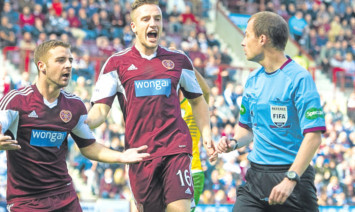
The publication of Mark Halsey’s autobiography, Added Time, has brought us back round to an all-too-familiar question. Should referees be seen and not heard?
The English official has prompted accusations of ego mania through revelations Jose Mourinho part-paid his holiday when his wife was ill, and that he would often make calls and texts to Sir Alex Ferguson.
While Ferguson has dismissed the claims as a “little bit Walter Mitty,” the Premier League are displeased and plan to be vigorous in their enforcement of the integrity laws in future.
Personally, I have always thought that here as with so many issues we need to try to apply some common sense.
If behaviour doesn’t sound right then it probably won’t be.
At the same time we need to acknowledge that these officials are human. They will make mistakes on and off the pitch. That has to be acknowledged by all sides.
When I was Chief Executive of the SFA, we ran an experiment where certain decisions could be clarified after the game. This was done not by the referee concerned, but by the department he worked for, which was then headed by Hugh Dallas.
Unfortunately it was to prove short-lived. After about a month, Hugh came to the conclusion it was making the situation worse, not better.
He reckoned that, for whatever reason, the explanations handed out were leading to more negativity rather than less.
My own view was people who complained didn’t so much want to hear explanations, as make the point that they believed certain decisions had been incorrect.
Time and time again people ask why refs make the decisions they do. And the answer is always so glaringly obvious they believe it to be the right response to the situation. They might be wrong, but they’re honest judgements.
Fans so often see hidden agendas or, worse, conspiracies. I simply don’t believe they exist.
Celtic’s penalty against Hearts was a big talking point last week. Willie Collum gave the award after a header from Anthony Stokes struck the hand of Jamie Hamill. The home side felt the ball had played him and argued vigorously that it shouldn’t have been a spot-kick.
Again, it has prompted calls for referees to be given the right to explain their decisions and I don’t think that’s a bad thing. Twitter allows for short, sharp messages to be sent out, to anyone who wants to see them, in an instant.
For me, though, the explanations would have to be definitive statements rather than the opening line in a debate.
Otherwise officials could find themselves waste hours of their time trying to defend themselves to people who are not really prepared to listen.
Communication is to be welcomed where possible but there is an onus on both sides to make an effort to be reasonable.

Enjoy the convenience of having The Sunday Post delivered as a digital ePaper straight to your smartphone, tablet or computer.
Subscribe for only £5.49 a month and enjoy all the benefits of the printed paper as a digital replica.
Subscribe